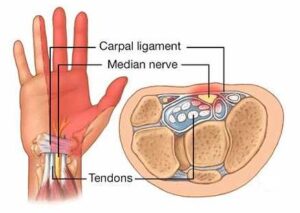Carpal Tunnel Syndrome is a condition that affects the wrist, causing numbness, tingling and pain in the affected hand. It can affect one hand only or occur bilaterally. It seems to affect women more frequently than men.
In order to understand how carpal tunnel syndrome develops, it helps to have a bit of understanding of the anatomy of the wrist. If we were to look at a cross section through the wrist, there is a passageway, or ‘tunnel’ about 2cm wide that allows passage of the nerves, tendons and blood vessels from the forearm to the hand.
 Some of the structures that pass through the tunnel include the flexor tendons, which allow movement of the fingers and the thumb; and the median nerve which is one of the main nerves to the hand.
Some of the structures that pass through the tunnel include the flexor tendons, which allow movement of the fingers and the thumb; and the median nerve which is one of the main nerves to the hand.
The median nerve provides sensation in the thumb and first two fingers and controls the muscles at the base of the thumb.
The tunnel is bordered by the carpal bones on the bottom and sides and the transverse carpal ligament across the top.
Carpal tunnel syndrome occurs when the median nerve is compressed due to narrowing of the tunnel or swelling of the tissues surrounding the flexor tendons.
This pressure on the median nerve results in pain, weakness, numbness and tingling in the hand, thumb and first two fingers. This may be mild or intermittent at first but can get gradually worse over time and become quite debilitating. The pain may also radiate up the arm towards the shoulder. There is often weakness of grip and general ‘clumsiness’ when trying to use the affected hand.
Many sufferers complain of symptoms that are worse at night and can affect the quality of sleep. Others find that specific activities such as driving or holding a mobile phone become increasingly difficult.
If left untreated it can lead to permanent damage to the median nerve, chronic, worsening pain and loss of function in the affected hand.
Common causes of carpal tunnel syndrome include:
- Repetitive use of the hands and wrists over prolonged periods of time.
- Repetitive extreme hand or wrist motions (flexion and extension) for prolonged periods of time.
- Hereditary factors – anatomical differences that make the carpal tunnel smaller than average, tend to run in families.
- Certain health conditions such as diabetes, rheumatoid arthritis, thyroid problems and pregnancy
Diagnosing carpal tunnel syndrome involves a physical examination of the affected hand and possibly additional tests such as nerve conduction studies, electromyogram (EMG) studies, ultrasounds, X-rays and MRI scans. Your doctor may need to refer you for these additional tests in order to exclude other possible explanations for the symptoms such as arthritis, damage to the ligaments, fractures or other nerve conditions such as neuropathy.
During the physical examination, the doctor will be looking or changes in sensitivity in the fingertips, weakness or wasting of the muscles around the thumb and sensations of numbness or tingling elicited by tapping or pressing down on the median nerve.
If a positive diagnosis is made there are a number of treatment options that can be suggested, depending on the severity and duration of symptoms. Symptoms are often triggered by occupational or recreational overuse of the wrist. If this is the case, treatment may be as simple as making ergonomic changes to your work station or modifying the way a task is performed.
Other non-surgical treatments that are often sufficient to relieve symptoms include wearing a wrist brace or splint, anti-inflammatory medication or corticosteroid injections. These treatments may need to continue for some time before any long term relief is achieved and for some people, this relief is only temporary.
In very severe cases, or where medication and injections have not been successful, a surgical treatment can be offered. The surgery is called a ‘carpal tunnel release’ or ‘decompression’ procedure which aims to increase the size of the carpal tunnel and in doing so, relieve the pressure on the median nerve. The surgery may be performed as an open procedure or endoscopically and both options have quite similar outcomes. There is often a long recovery time post-surgery and you may require modifications to your day to day activities and work activities while your wrist heals. Your Doctor may also refer you for post-operative physiotherapy or hand therapy to assist in recovery and restrengthening.
Carpal tunnel syndrome is much easier to treat in its early stages, so if you have symptoms of pain, numbness or tingling in your hands and fingers, it is worthwhile getting it checked by your Doctor.




